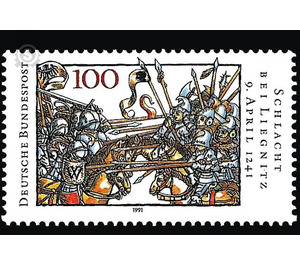750th anniversary of the battle of Liegnitz - Germany / Federal Republic of Germany 1991 - 100 Pfennig
Theme: Calender
| Country | Germany / Federal Republic of Germany |
| Issue Date | 1991 |
| Face Value | 100.00 |
| Color | multi-colored white |
| Perforation | K 14 |
| Printing Type | combined intaglio and offset printing |
| Stamp Type | Postage stamp |
| Item Type | Stamp |
| Chronological Issue Number | 1384 |
| Chronological Chapter | GER-BRD |
| SID | 193904 |
| In 37 Wishlists | |
Soon after 1200, a new great power emerged in Inner Asia (around Lake Baikal), which initially went unnoticed in Europe: the Mongol empire, also called the Tartars, which a victorious tribal leader, Genghis Khan, had united under his rule. As moving cavalry warriors, they quickly advanced eastward towards China and westward into Persia and Russia. Their expansive impact, carried also by Islamic Turkic peoples, continued beyond the death of the founder of the empire (1227) and helped them, under the leadership of Genghis Khan's grandson Batu, to storm Moscow in 1238 and from Kiev in 1240. Since their goals reached even further, they made 1241 coordinated advances to Poland and Hungary. A joint defense of the frightened European rulers and peoples did not come about, especially as Emperor Frederick II and Pope Gregory IX. just then in Italy were in bitter dispute. Thus, it was left to the directly affected regional rulers to stop the invaders. After Krakow and Wroclaw were already devastated, on April 9, 1241, the Silesian Duke Henry II, who came from the Polish princely family of the Piast dynasty, and son of St. Hedwig from the Bavarian Count Andechs was at the head of a numerically defeated squad of Poles and Germans as well as members of the international knightly orders on the Wahlstatt at Liegnitz for battle, in which the Mongols after a tough fight kept the upper hand. Duke Henry and many others found death; only the losses of the Templerordens, which are documented, amounted to 500 fallen. The winners did not use their success in the expected sense, but turned after a brief advance in the Lusatia south to Hungary, where concentrated after a simultaneous defeat of the local king, the Mongol forces in the fall of 1241. However, the feared further plundering raids were missing, as Batu responded to the news of the death of the Great Khan in Karakorum in 1242 with a retreat to the lower Volga. For Western and Central Europe the danger was as fast as it had turned up, while for centuries Russia fell under the rule of the Tatar "Golden Horde." The fight at Liegnitz, which did not conquer the Mongols, but opposed their stormy advance for the first time vigorously resisted, arose from the common defense will Polish princes and German settlers. He remained in glorious memory, which combined with the memory of the two years later died Silesian "Mother of State" Hedwig. This also resulted in the image certificate reproduced on the stamp. It shows the collision of the two armies and is based on a miniature in a richly illustrated manuscript with descriptions of the life of St. Hedwig, which was made a century later (1353) for Duke Ludwig I of Liegnitz-Brieg, married to a great-granddaughter of the fallen Henry. This so-called Schlacken Werther Codex (named after its Bohemian repository in the 18th / 19th century, today Ostrov / CSFR) now belongs to the J. Paul Getty Museum in Malibu (California). (Text: Professor Dr. Rudolf Schieffer - History Department of the Rheinische Friedrich-Wilhelms University Bonn)


